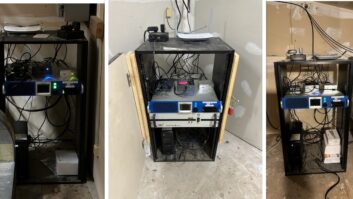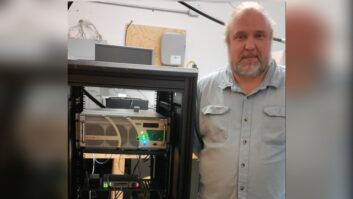
The DM Broadcast custom-designed presenter and guest
console accommodates all the equipment required to operate
the Dira FM visual radio studio. In the foreground, the DJ set
featuring two Pioneer CDJ900 multiformat media players.
DAR ES SALAAM, Tanzania — Dar es Salaam (“The Residence of Peace”) is the largest city by population in Tanzania and in Eastern Africa. It is also Tanzania’s leading financial and cultural center.
Both the www.worldradiomap.com and the www.radio-africa.org websites report more than 30 FM radio stations are currently receivable in Dar es Salaam.
INVESTMENTS
According to Marco Giovannini, CEO at Italian systems integrator DM Broadcast, the radio business in the city is healthy, and several investors are entering the media industry, providing capital and establishing new stations.
Dira Media Group Co. Ltd., owner of Dira FM and Dira TV, based in Dar es Salaam, is one example. It recently entrusted DM Broadcast with the turnkey supply of a new, integrated radio and TV facility, designed and implemented for both independent and synergic operation. The installation included a complete TV studio, with studio equipment, cameras and a room to host the playout equipment, as well as a complete visual radio studio.
“Dira FM is Tanzania’s first station to adopt the visualization of radio,” Giovannini explained. The station, which is currently carrying out on-air tests and expects to be fully operational within the coming weeks, covers the metropolitan area of Dar es Salaam via FM. The visual stream will be available via digital terrestrial TV. Dira is also distributing the visual stream via the web too.
“We based our design of the Dira integrated radio and TV facility on a really new concept,” Giovannini said. “A single operator in the master control room can manage and combine the master feed from both the TV and radio playout. Under standard operating conditions, the radio master feed flows to the FM delivery chain, and the TV master feed goes to the TV delivery chain.”

The visual director working area includes an AEV BSM
Evolution USB audio mixer, the Telos VSet6 phone controller,
the pad to manage the video feeds, and the DM Broadcast
Vibe 6 processor with RDS encoder.
FULLY FLEXIBLE
Simultaneously, the visual radio master feed includes the audio from the FM radio feed and the associated video content. When required, the master control room can deliver the audio track of the TV feed as the main radio feed, thus also broadcasting the audio for TV via the FM transmitter. The visual radio feed can also be routed to feed the video encoder of the TV channel, preserving the original TV audio.
In addition, it is possible for the complete visual radio feed to be broadcast as the main video feed of the TV station, and vice-versa. “A dedicated audio and video mixer placed in the master control room enables this flexibility,” Giovannini said, “and can also act as a playout backup.”
DM Broadcast designed Dira FM’s visual radio studio on a dual-layer concept. The core layer provides the audio feed, while a dedicated additional layer provides a radio-flavored visual feed. The audio layer is based around an AEV BSM Evolution USB audio mixer, featuring four mic inputs, two line inputs and two telephone hybrids.
The studio features a DM Broadcast custom-designed speaker and guest console that is equipped with four AKG Perception 420 mics. The two telephone hybrids built into the AEV mixer are currently not in use. DM Broadcast instead implemented a Telos VSet6 six-line phone controller.
Dira FM will also produce live shows, so studio equipment includes a DJ set with two Pioneer CDJ900 multiformat media players. The control room includes two JBL 305 monitors and the DM Broadcast Vibe 6 six-band audio processor with an RDS encoder.

Filippo Mazzanti, L, commissioning engineer at DM Broadcast,
conducts a training session for Hassan Kundamayi,
senior engineer at Dira Media Group.
VIDEO FOLLOWS AUDIO
The visual layer of the studio is shaped around the DM Broadcast Fluo Radio Vision system, capable of ingesting and managing up to four HDMI or SDI signals. Three Canon XA25 camcorders capture three different angles of what’s going on in the studio.
A special pad connected to the Fluo Radio Vision allows the person handling the station’s visual feed to manage the cameras and the shots, choose the on-air camera, add graphic overlays, insert logos, visual effects as well as picture-in-picture, for example combining a video feed from the studio with video content captured live from the web.
The studio cameras can be automatically managed by the Fluo Radio Vision system, which can switch to a specific camera according to the mic in use (through voice-activation) as well as when a predetermined event occurs. For example, when a telephone call goes live, the Fluo Radio Vision can play selected graphic content over the video feed.
When the Fluo Radio Vision detects input signals on more than one mic, it performs the action included in the presets for that particular radio show. It can, for instance, switch to a panoramic camera or combine the video from two cameras into a picture-in-picture.
Multiple presets can be defined, in terms of both actions to be performed following a specific trigger, and for the positioning of the cameras within the studio, according to the specific show being produced.

Marco Giovannini is CEO at DM Broadcast.
“We chose the Canon XA25, a broadcast-grade ENG camcorder, because these cameras can also be used outdoors to produce both radio and TV contributions,” explained Giovannini.
“When just one DJ is in the studio, one camera is enough to produce the visual feed, so outside production crews can take with them the remaining two cameras.”
SINGLE SERVER
A single server as well as a single database manage both video and audio content. The Filo Media Manager, also manufactured by DM Broadcast, features a playout server for both audio and video files.
By default the Filo Media Manager conforms to the “video follows audio” criterion. When the playback of the selected audio file starts, the playback of the associated video content starts. If no associated video content is available, the Filo Media Manager switches to a specific video filler or to a random video filler, as well as to a graphic image.
The Fluo Radio Vision system includes a software application capable of organizing listeners’ SMS and social media contributions. As soon as radio staff approves the received message for publication, Fluo Radio Vision delivers it on the visual feed.
“We also provided Dira FM staff with comprehensive training, to help them understand the great potential of the visual radio concept,” Giovannini concluded. “Dira FM is Tanzania’s first visual radio station, so we introduced them to the best visual radio practices that have been adopted by radio stations all over the world.”
Davide Moro reports on the industry for Radio World from Bergamo, Italy.












